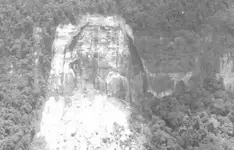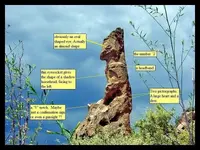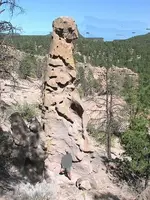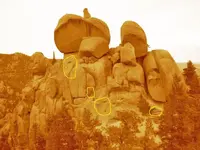Springfield,
Seems like somebody else found some large column like stones in the west.
t It was in August, 1749, that Kalm held a conversation with M. de La Verendrye, which he records. His narrative is worthy of attention when the character of the expedition I have attempted to describe is considered. "They set out on horseback from Montreal and went as much due west as they could on account of the lakes, rivers and mountains which fell in their way. As they came far into the country beyond many nations they sometimes met with large tracts of land free from wood, but covered with a kind of very tall grass, for the space of some days' journey. Many of these fields were everywhere covered with furrows, as if they had been ploughed and sown formerly. It is to be observed that the nations which now inhabit North America could not cultivate the land in this manner, because they never made use of horses, oxen, ploughs, or any instruments of husbandry, nor had they ever seen a plough before the Europeans came to
them When they came far to the west, where to the best of their
knowledge, no Frenchman or European had ever been, they found in one place in the woods, and again on a large plain, great pillars of stone leaning upon each other. The pillars consisted of one single stone each, and the Frenchmen could not but suppose that they had been erected by human hands. Sometimes they have found such stones laid upon one another, and as it were, formed into a wall. In some of those places where they found such stones they could not find any other sorts of stones. They have not been able to discover any characters or writing upon any of these stones, though they have made a very careful search after them. At last, they met with a large stone like a pillar, and in it a smaller stone was fixed, which was covered on both sides with unknown characters. This stone, which was about a foot of French measure in length, and between four or five inches broad, they broke loose and carried to Canada with them, from whence it was sent to France to the secretary of state, the count of Maurepas. What became of it afterwards is unknown to them, but they think it is yet preserved in his collection. Several of the jesuits who have seen and handled this stone in Canada unanimously affirm that the letters on it are the same with those which in the books containing accounts of Tataria, are called Tatarian characters, and that on comparing both together, they found them perfectly alike. Notwithstanding the questions which the French on the south-sea expedition asked the people there concerning the time when and by whom those pillars were erected? what their traditions and sentiments concerning them were? who had wrote the characters? what was meant by them? what kind of letters they were? in what language they were written? and other circumstances ; yet they could never get the least explication, the Indians being as ignorant of all those things as the French themselves. All they could say was that these stones had been in those places since times immemorial. The places where the pillars stood were near nine hundred French miles westward of Montreal. The chief intention of this journey, viz., to come to the south-sea and to examine its distance from Canada, was never attained on this occasion. For the people sent out for that purpose were induced to take part in a war between some of the most distant Jntiian nations, in which some of the French were taken prisoners and the rest obliged to return. Among the last and most westerly Indians they were with, they heard that the South sea was but a few days' journey off; that they (the Indians) often traded with the Sfaniards on that coast, and sometimes likewise they went to Hudson's Bay to trade with the English. Some of these Indians had houses which were made of earth. Many nations had never seen any Frenchmen. They were commonly clad in skins, but many were quite naked." Kalm, III., pp. 123-128.
If you google Verendrye Stone , you will find some people believe there is a connection with the rune stone found in Kensington, Minnesota. Will not be proven though.
Rick









 ..'nother page in my field notebook..
..'nother page in my field notebook..